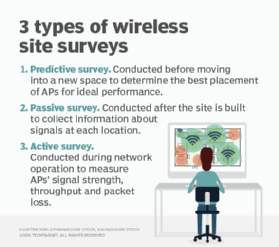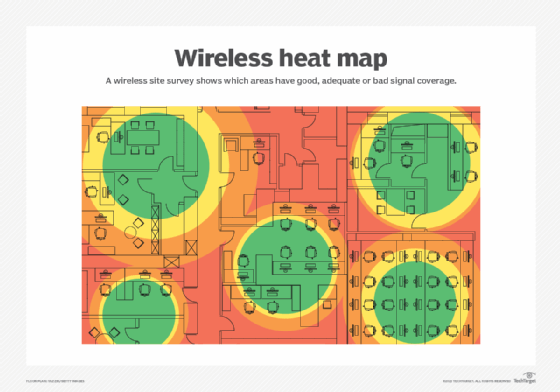3 types of wireless site surveys and how to conduct them (original) (raw)
Designing and maintaining networks has always been complicated, but wireless networks are more complicated than wired networks. With a wired network, throughput doesn't change when you move a desk or steel file cabinet a few feet, but either of these changes can affect a signal path and change wireless performance.
Wireless pros must take care when designing wireless networks for new offices, factories or warehouses. The network should provide good wireless coverage and signal strength, whether it's connecting computers and printers, automated factory machinery or warehouse inventory systems.
Wireless site surveys are essential to ensure excellent network performance from day one. Site surveys are also necessary to maintain the network so it continues to provide the same level of service.
What is a wireless site survey?
A wireless site survey analyzes the radio frequency environment of an area where a Wi-Fi network is deployed. Network teams use site surveys when planning a new network to determine where to install access points (APs).
Teams should also conduct periodic site surveys while the network is operating. Changes to office floor plans and layouts, such as the movement or addition of desks or file cabinets, might require changes to AP locations. New equipment might need a high level of signal strength in a location that doesn't provide the required signal levels. New applications or increased use of an existing application might also require improved performance. A site survey can determine any necessary changes to the network.
A wireless site survey analyzes the radio frequency environment of an area where a Wi-Fi network is deployed.
Types of wireless site surveys
A comprehensive evaluation requires three types of wireless site surveys, with each survey performing a different function, as seen below:
- Predictive surveys are performed before moving into a new space.
- Passive surveys collect information about all the signals in the environment after the site is built.
- Active surveys focus on a specific signal or set of signals while the network is in full operation.
Predictive site surveys
The goal of a predictive site survey is to determine where to place APs for the best performance throughout the area.
Network teams should perform a predictive survey before moving any equipment or furniture into a new space. A predictive survey relies on network tools designed to predict how wireless signals propagate through a space. The input is a detailed set of blueprints and information on the type of wireless equipment proposed, such as which Wi-Fi standard the area will use.

Compare the three types of wireless site surveys.
Recent updates to IEEE standards have added improvements that can affect where to place APs and how many are needed. Wi-Fi 4, based on IEEE 802.11n, introduced multiple input, multiple output (MIMO), which sends data through multiple paths to increase data rates and transmission distance. Wi-Fi 5, based on IEEE 802.11ac, introduced beamforming. With beamforming, an AP monitors the direction from which return traffic comes from a Wi-Fi device and then sends data directly to the device rather than broadcasting in all directions.
The releases of Wi-Fi 6 and 6E improved MIMO and beamforming features. The newer standards provide higher data rates and increased distance between AP and device.
In a predictive site survey, the blueprint shows virtual APs, and the survey software determines signal strength based on information about how signals propagate through walls and around cabinets and desks. The software also factors in the types of applications used in the area -- e.g., heavy video use requires high throughput, while VoIP calls don't require high throughput, but do require tight limits on latency and delay.
Virtual APs can be placed automatically or manually in a survey. With automatic location positioning, the software chooses where to place APs, using the same AP model everywhere. Manual placement enables network managers to select locations and specify the proposed AP model for each location -- e.g., a more powerful model in some locations and a less powerful model in others.
Passive site surveys
The goal of a passive survey is to report on all signals at each location, including the installed network and signals from neighboring sites or other devices that generate noise at wireless frequencies.
Teams should perform passive surveys periodically after they build the site, install equipment and activate the network. These surveys report information on APs and their characteristics, signal strength, signal-to-noise ratios and interference. They might reveal marginal performance changes before users notice.
Active site surveys
Active surveys focus on a specific signal or set of specific signals and produce an extensive list of measurements for each AP that generates a studied signal. These measurements include signal strength, throughput, round-trip time, packet loss and retransmission rate throughout the area where the signal is used. Active site surveys also measure upstream and downstream data rates and might result in teams moving an AP or adding or removing an unneeded AP. Teams should perform active surveys when investigating performance problems.
The importance of wireless site surveys
It might be tempting for network teams to avoid the cost of doing a site survey. Often, teams want to use rule-of-thumb guidelines to determine how many APs a given area needs. The estimate might be adequate for some deployments, but it could also result in more or fewer APs than applications and performance levels require. Even if the estimated number of APs is accurate, guesses about where to locate the APs might not provide the performance needed.
In the end, skipping a site survey could result in larger costs due to the extra cost of buying and installing more APs than needed. Not installing enough APs might result in user complaints of poor performance. Adding more units and moving existing ones later are more expensive than installing the right number in the right places initially.
What does a site survey show?
The initial input to a wireless site survey includes a blueprint that shows the placement of walls, desks and other equipment. The survey then produces several types of output. It generates a heat map, which is a color-coded map that shows signal strength throughout the area based on where APs are placed. If the map shows that strength is too low in some places, teams can move APs or add units.

A heat map shows where wireless coverage is strong, weak or average.
The display also shows network noise levels, signal-to-noise ratios, interference, throughput, data rates, packet losses and retries. They can also display indicators of VoIP performance.
The survey can produce a spectrum analysis that measures the strength of Wi-Fi signals and interference from nearby Wi-Fi networks, signals or other sources, such as Bluetooth, portable phones or microwave ovens.
The survey can detect devices that shouldn't be connected to the network. For example, employee-owned laptops, phones and tablets can be a source of infection if they don't have antivirus software or have products installed that aren't as comprehensive as enterprise-selected packages.
Who performs wireless site surveys?
The following entities can perform wireless site surveys:
- consulting firms;
- individuals with expertise in wireless technology; and
- in-house personnel with equivalent expertise who are up to date on the latest standards and equipment capabilities.
Periodic IEEE releases of new wireless specifications and vendor updates result in products with new capabilities that might enable network changes.
Tools for a wireless site survey
Network teams can conduct basic site surveys using free or inexpensive software installed on a laptop or tablet.
In contrast, specialized hardware and software can cost thousands of dollars, but they produce a detailed picture of network operations. For example, specialized survey tools can gather and display information about the wireless environment, including network operations and the level of external noise. They also communicate with APs to gather information about the signals they produce and query end-user equipment about received signal strength and data rates.
Wireless network technology has made and continues to make steady progress, and it now supports applications that previously required a wired network. Nevertheless, a wireless network requires constant maintenance to ensure excellent performance. Wireless site surveys can help network teams ensure their wireless networks meet coverage and performance requirements.